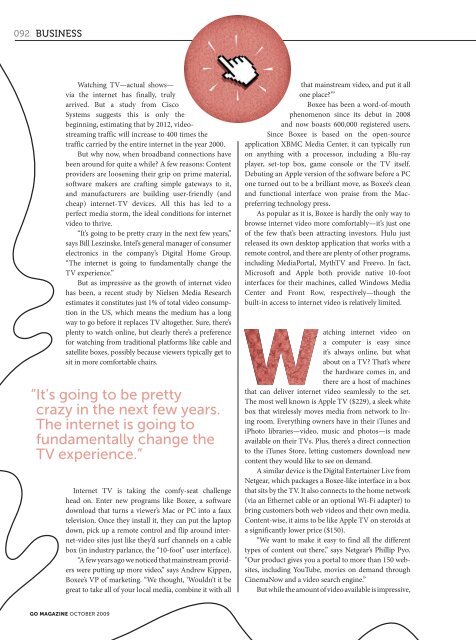You also want an ePaper? Increase the reach of your titles
YUMPU automatically turns print PDFs into web optimized ePapers that Google loves.
092<br />
BUSINESS<br />
Watching TV—actual shows—<br />
via the internet has finally, truly<br />
arrived. But a study from Cisco<br />
Systems suggests this is only the<br />
beginning, estimating that by 2012, videostreaming<br />
traffic will increase to 400 times the<br />
traffic carried by the entire internet in the year 2000.<br />
But why now, when broadband connections have<br />
been around for quite a while? A few reasons: Content<br />
providers are loosening their grip on prime material,<br />
software makers are crafting simple gateways to it,<br />
and manufacturers are building user-friendly (and<br />
cheap) internet-TV devices. All this has led to a<br />
perfect media storm, the ideal conditions for internet<br />
video to thrive.<br />
“It’s going to be pretty crazy in the next few years,”<br />
says Bill Leszinske, Intel’s general manager of consumer<br />
electronics in the company’s Digital Home Group.<br />
“The internet is going to fundamentally change the<br />
TV experience.”<br />
But as impressive as the growth of internet video<br />
has been, a recent study by Nielsen Media Research<br />
estimates it constitutes just 1% of total video consumption<br />
in the US, which means the medium has a long<br />
way to go before it replaces TV altogether. Sure, there’s<br />
plenty to watch online, but clearly there’s a preference<br />
for watching from traditional platforms like cable and<br />
satellite boxes, possibly because viewers typically get to<br />
sit in more comfortable chairs.<br />
“ It’s going to be pretty<br />
crazy in the next few years.<br />
The internet is going to<br />
fundamentally change the<br />
TV experience.”<br />
Internet TV is taking the comfy-seat challenge<br />
head on. Enter new programs like Boxee, a software<br />
download that turns a viewer’s Mac or PC into a faux<br />
television. Once they install it, they can put the laptop<br />
down, pick up a remote control and flip around internet-video<br />
sites just like they’d surf channels on a cable<br />
box (in industry parlance, the “10-foot” user interface).<br />
“A few years ago we noticed that mainstream providers<br />
were putting up more video,” says Andrew Kippen,<br />
Boxee’s VP of marketing. “We thought, ‘Wouldn’t it be<br />
great to take all of your local media, combine it with all<br />
GO MAGAZINE OCTOBER <strong>2009</strong><br />
that mainstream video, and put it all<br />
one place?’”<br />
Boxee has been a word-of-mouth<br />
phenomenon since its debut in 2008<br />
and now boasts 600,000 registered users.<br />
Since Boxee is based on the open-source<br />
application XBMC Media Center, it can typically run<br />
on anything with a processor, including a Blu-ray<br />
player, set-top box, game console or the TV itself.<br />
Debuting an Apple version of the software before a PC<br />
one turned out to be a brilliant move, as Boxee’s clean<br />
and functional interface won praise from the Macpreferring<br />
technology press.<br />
As popular as it is, Boxee is hardly the only way to<br />
browse internet video more comfortably—it’s just one<br />
of the few that’s been attracting investors. Hulu just<br />
released its own desktop application that works with a<br />
remote control, and there are plenty of other programs,<br />
including MediaPortal, MythTV and Freevo. In fact,<br />
Microsoft and Apple both provide native 10-foot<br />
interfaces for their machines, called Windows Media<br />
Center and Front Row, respectively—though the<br />
built-in access to internet video is relatively limited.<br />
atching internet video on<br />
a computer is easy since<br />
it’s always online, but what<br />
about on a TV? That’s where<br />
the hardware comes in, and<br />
there are a host of machines<br />
that can deliver internet video seamlessly to the set.<br />
The most well known is Apple TV ($229), a sleek white<br />
box that wirelessly moves media from network to living<br />
room. Everything owners have in their iTunes and<br />
iPhoto libraries—video, music and photos—is made<br />
available on their TVs. Plus, there’s a direct connection<br />
to the iTunes Store, letting customers download new<br />
content they would like to see on demand.<br />
A similar device is the Digital Entertainer Live from<br />
Netgear, which packages a Boxee-like interface in a box<br />
that sits by the TV. It also connects to the home network<br />
(via an Ethernet cable or an optional Wi-Fi adapter) to<br />
bring customers both web videos and their own media.<br />
Content-wise, it aims to be like Apple TV on steroids at<br />
a significantly lower price ($150).<br />
“We want to make it easy to find all the different<br />
types of content out there,” says Netgear’s Phillip Pyo.<br />
“Our product gives you a portal to more than 150 websites,<br />
including YouTube, movies on demand through<br />
CinemaNow and a video search engine.”<br />
But while the amount of video available is impressive,
















